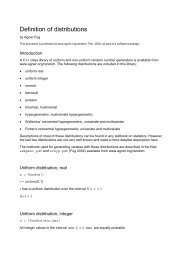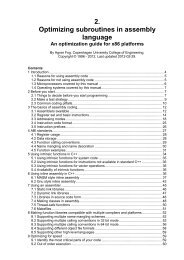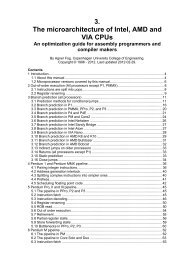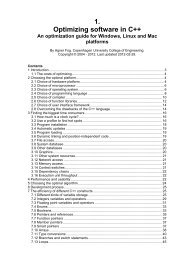4 Instruction tables - Agner Fog
4 Instruction tables - Agner Fog
4 Instruction tables - Agner Fog
Create successful ePaper yourself
Turn your PDF publications into a flip-book with our unique Google optimized e-Paper software.
Nehalem<br />
Intel Nehalem<br />
List of instruction timings and μop breakdown<br />
Explanation of column headings:<br />
Operands:<br />
i = immediate data, r = register, mm = 64 bit mmx register, xmm = 128 bit xmm<br />
register, (x)mm = mmx or xmm register, sr = segment register, m = memory,<br />
m32 = 32-bit memory operand, etc.<br />
μops fused domain:<br />
μops unfused domain:<br />
The number of μops at the decode, rename, allocate and retirement stages in<br />
the pipeline. Fused μops count as one.<br />
The number of μops for each execution port. Fused μops count as two. Fused<br />
macro-ops count as one. The instruction has μop fusion if the sum of the numbers<br />
listed under p015 + p2 + p3 + p4 exceeds the number listed under μops<br />
fused domain. An x under p0, p1 or p5 means that at least one of the μops listed<br />
under p015 can optionally go to this port. For example, a 1 under p015 and<br />
an x under p0 and p5 means one μop which can go to either port 0 or port 5,<br />
whichever is vacant first. A value listed under p015 but nothing under p0, p1<br />
and p5 means that it is not known which of the three ports these μops go to.<br />
p015: The total number of μops going to port 0, 1 and 5.<br />
p0: The number of μops going to port 0 (execution units).<br />
p1: The number of μops going to port 1 (execution units).<br />
p5: The number of μops going to port 5 (execution units).<br />
p2: The number of μops going to port 2 (memory read).<br />
p3: The number of μops going to port 3 (memory write address).<br />
p4: The number of μops going to port 4 (memory write data).<br />
Domain:<br />
Tells which execution unit domain is used: "int" = integer unit (general purpose<br />
registers), "ivec" = integer vector unit (SIMD), "fp" = floating point unit (XMM<br />
and x87 floating point). An additional "bypass delay" is generated if a register<br />
written by a μop in one domain is read by a μop in another domain. The bypass<br />
delay is 1 clock cycle between the "int" and "ivec" units, and 2 clock cycles<br />
between the "int" and "fp", and between the "ivec" and "fp" units.<br />
The bypass delay is indicated under latency only where it is unavoidable because<br />
either the source operand or the destination operand is in an unnatural<br />
domain such as a general purpose register (e.g. eax) in the "ivec" domain. For<br />
example, the PEXTRW instruction executes in the "int" domain. The source<br />
operand is an xmm register and the destination operand is a general purpose<br />
register. The latency for this instruction is indicated as 2+1, where 2 is the<br />
latency of the instruction itself and 1 is the bypass delay, assuming that the<br />
xmm operand is most likely to come from the "ivec" domain. If the xmm operand<br />
comes from the "fp" domain then the bypass delay will be 2 rather than<br />
one. The flags register can also have a bypass delay. For example, the<br />
COMISS instruction (floating point compare) executes in the "fp" domain and<br />
returns the result in the integer flags. Almost all instructions that read these<br />
flags execute in the "int" domain. Here the latency is indicated as 1+2, where 1<br />
is the latency of the instruction itself and 2 is the bypass delay from the "fp"<br />
domain to the "int" domain.<br />
The bypass delay from the memory read unit to any other unit and from any<br />
unit to the memory write unit are included in the latency figures in the table.<br />
Where the domain is not listed, the bypass delays are either unlikely to occur or<br />
unavoidable and therefore included in the latency figure.<br />
Page 106






